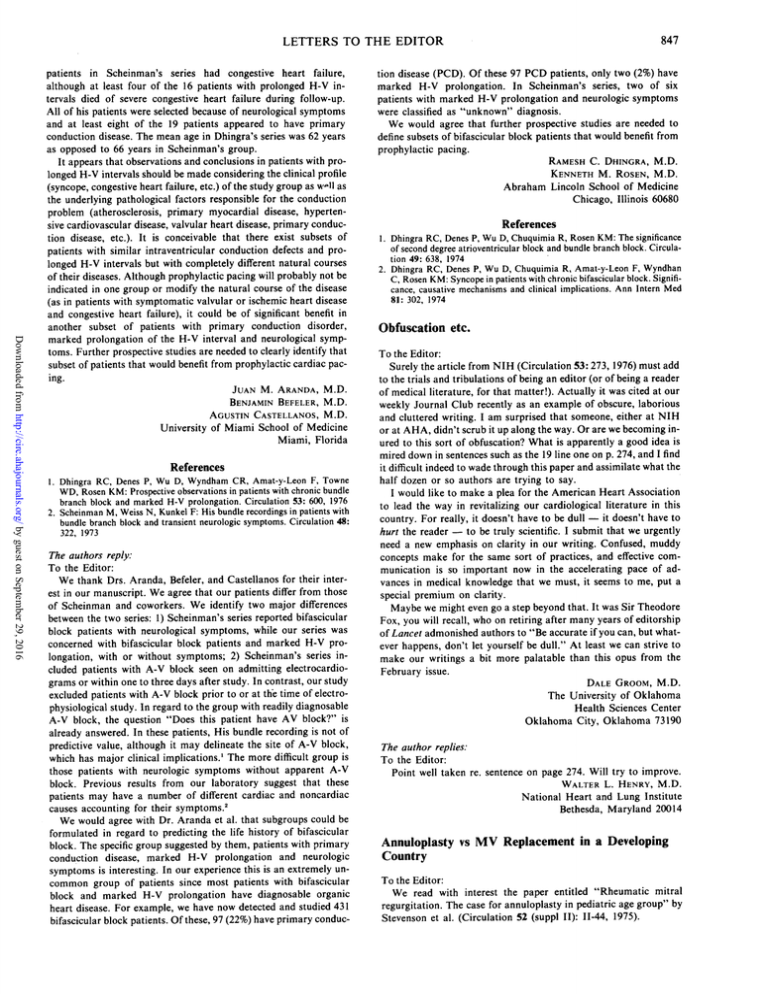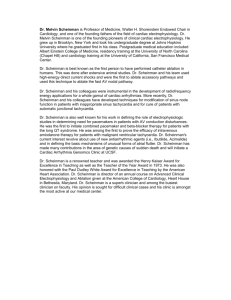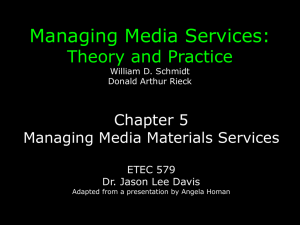Annuloplasty vs MV Replacement in a Developing Country
advertisement

847 LETTERS TO THE EDITOR Downloaded from http://circ.ahajournals.org/ by guest on September 29, 2016 patients in Scheinman's series had congestive heart failure, although at least four of the 16 patients with prolonged H-V intervals died of severe congestive heart failure during follow-up. All of his patients were selected because of neurological symptoms and at least eight of the 19 patients appeared to have primary conduction disease. The mean age in Dhingra's series was 62 years as opposed to 66 years in Scheinman's group. It appears that observations and conclusions in patients with prolonged H-V intervals should be made considering the clinical profile (syncope, congestive heart failure, etc.) of the study group as wl11 as the underlying pathological factors responsible for the conduction problem (atherosclerosis, primary myocardial disease, hypertensive cardiovascular disease, valvular heart disease, primary conduction disease, etc.). It is conceivable that there exist subsets of patients with similar intraventricular conduction defects and prolonged H-V intervals but with completely different natural courses of their diseases. Although prophylactic pacing will probably not be indicated in one group or modify the natural course of the disease (as in patients with symptomatic valvular or ischemic heart disease and congestive heart failure), it could be of significant benefit in another subset of patients with primary conduction disorder, marked prolongation of the H-V interval and neurological symptoms. Further prospective studies are needed to clearly identify that subset of patients that would benefit from prophylactic cardiac pacing. JUAN M. ARANDA, M.D. BENJAMIN BEFELER, M.D. AGUSTIN CASTELLANOS, M.D. University of Miami School of Medicine Miami, Florida References 1. Dhingra RC, Denes P, Wu D, Wyndham CR, Amat-y-Leon F, Towne WD, Rosen KM: Prospective observations in patients with chronic bundle branch block and marked H-V prolongation. Circulation 53: 600, 1976 2. Scheinman M, Weiss N, Kunkel F: His bundle recordings in patients with bundle branch block and transient neurologic symptoms. Circulation 48: 322, 1973 The authors reply: To the Editor: We thank Drs. Aranda, Befeler, and Castellanos for their interest in our manuscript. We agree that our patients differ from those of Scheinman and coworkers. We identify two major differences between the two series: 1) Scheinman's series reported bifascicular block patients with neurological symptoms, while our series was concerned with bifascicular block patients and marked H-V prolongation, with or without symptoms; 2) Scheinman's series included patients with A-V block seen on admitting electrocardiograms or within one to three days after study. In contrast, our study excluded patients with A-V block prior to or at the time of electrophysiological study. In regard to the group with readily diagnosable A-V block, the question "Does this patient have AV block?" is already answered. In these patients, His bundle recording is not of predictive value, although it may delineate the site of A-V block, which has major clinical implications.' The more difficult group is those patients with neurologic symptoms without apparent A-V block. Previous results from our laboratory suggest that these patients may have a number of different cardiac and noncardiac causes accounting for their symptoms.2 We would agree with Dr. Aranda et al. that subgroups could be formulated in regard to predicting the life history of bifascicular block. The specific group suggested by them, patients with primary conduction disease, marked H-V prolongation and neurologic symptoms is interesting. In our experience this is an extremely uncommon group of patients since most patients with bifascicular block and marked H-V prolongation have diagnosable organic heart disease. For example, we have now detected and studied 431 bifascicular block patients. Of these, 97 (22%) have primary conduc- tion disease (PCD). Of these 97 PCD patients, only two (2%) have marked H-V prolongation. In Scheinman's series, two of six patients with marked H-V prolongation and neurologic symptoms were classified as "unknown" diagnosis. We would agree that further prospective studies are needed to define subsets of bifascicular block patients that would benefit from prophylactic pacing. 1. 2. RAMESH C. DHINGRA, M.D. KENNETH M. ROSEN, M.D. Abraham Lincoln School of Medicine Chicago, Illinois 60680 References Dhingra RC, Denes P, Wu D, Chuquimia R, Rosen KM: The significance of second degree atrioventricular block and bundle branch block. Circulation 49: 638, 1974 Dhingra RC, Denes P, Wu D, Chuquimia R, Amat-y-Leon F, Wyndhan C, Rosen KM: Syncope in patients with chronic bifascicular block. Significance, causative mechanisms and clinical implications. Ann Intern Med 81: 302, 1974 Obfuscation etc. To the Editor: Surely the article from NIH (Circulation 53: 273, 1976) must add to the trials and tribulations of being an editor (or of being a reader of medical literature, for that matter!). Actually it was cited at our weekly Journal Club recently as an example of obscure, laborious and cluttered writing. I am surprised that someone, either at NIH or at AHA, didn't scrub it up along the way. Or are we becoming inured to this sort of obfuscation? What is apparently a good idea is mired down in sentences such as the 19 line one on p. 274, and I find it difficult indeed to wade through this paper and assimilate what the half dozen or so authors are trying to say. I would like to make a plea for the American Heart Association to lead the way in revitalizing our cardiological literature in this country. For really, it doesn't have to be dull it doesn't have to hurt the reader - to be truly scientific. I submit that we urgently need a new emphasis on clarity in our writing. Confused, muddy concepts make for the same sort of practices, and effective communication is so important now in the accelerating pace of advances in medical knowledge that we must, it seems to me, put a - special premium on clarity. Maybe we might even go a step beyond that. It was Sir Theodore Fox, you will recall, who on retiring after many years of editorship of Lancet admonished authors to "Be accurate if you can, but whatever happens, don't let yourself be dull." At least we can strive to make our writings a bit more palatable than this opus from the February issue. DALE GROOM, M.D. The University of Oklahoma Health Sciences Center Oklahoma City, Oklahoma 73190 The author replies: To the Editor: Point well taken re. sentence page 274. Will try to improve. WALTER L. HENRY, M.D. National Heart and Lung Institute Bethesda, Maryland 20014 Annuloplasty Country vs MV on Replacement in a Developing To the Editor: We read with interest the paper entitled "Rheumatic mitral regurgitation. The case for annuloplasty in pediatric age group" by Stevenson et al. (Circulation 52 (suppl II): 11-44, 1975). Annuloplasty vs MV replacement in a developing country. I Aryanpur and J G Shakibi Downloaded from http://circ.ahajournals.org/ by guest on September 29, 2016 Circulation. 1976;54:847-848 doi: 10.1161/01.CIR.54.5.847 Circulation is published by the American Heart Association, 7272 Greenville Avenue, Dallas, TX 75231 Copyright © 1976 American Heart Association, Inc. All rights reserved. Print ISSN: 0009-7322. Online ISSN: 1524-4539 The online version of this article, along with updated information and services, is located on the World Wide Web at: http://circ.ahajournals.org/content/54/5/847.citation Permissions: Requests for permissions to reproduce figures, tables, or portions of articles originally published in Circulation can be obtained via RightsLink, a service of the Copyright Clearance Center, not the Editorial Office. Once the online version of the published article for which permission is being requested is located, click Request Permissions in the middle column of the Web page under Services. Further information about this process is available in the Permissions and Rights Question and Answer document. Reprints: Information about reprints can be found online at: http://www.lww.com/reprints Subscriptions: Information about subscribing to Circulation is online at: http://circ.ahajournals.org//subscriptions/

